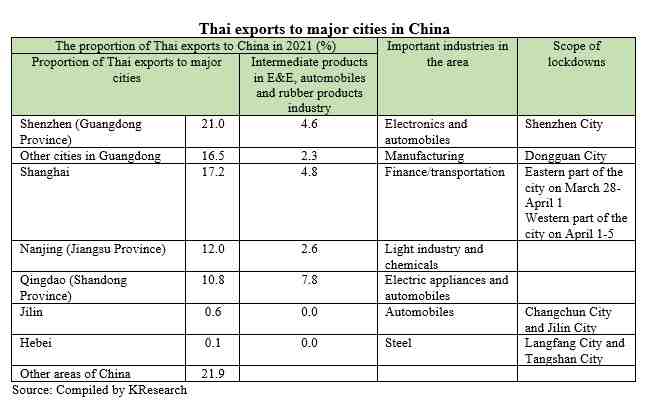Chinese authorities have announced lockdowns in many cities in China, posing a risk to Thailand’s intermediate product exports to China. This risk should be monitored because Thai exports to China are currently dominated by intermediate goods and capital goods, which account for 53% of exports. Lockdown measures have been implemented in major manufacturing and economic cities; therefore Thai exports may be affected. Most recently, Chinese authorities have added a lockdown in the western part of Shanghai on April 1-5, and will continue the lockdown in the eastern part of Shanghai from March 28 to April 1. Previously, Shenzhen and Dongguan in Guangdong Province, Changchun and Jilin in Jilin Province, and Langfang and Tangshan in Hebei Province have all announced lockdowns.
This outbreak of the Omicron variant of COVID-19 is the most severe outbreak since the first outbreak in Wuhan, Hubei Province in 2019, and the outbreak areas are all important economic cities in China. Particularly, Shanghai plays an important role in the size of the economy and the country’s financial center. Although Shenzhen is one of 21 cities in Guangdong Province, it is the fourth largest economic cities in China, following Shanghai, Beijing and Guangzhou (capital of Guangdong Province), and is also a global production base for smartphones and automobiles, a Southern logistics hub with the second largest shipping port in China and the third largest in the world. Jilin Province has a Japanese automobile manufacturing base, while Hebei Province is an important steel production base in China.
In addition, areas under lockdowns are all located on the eastern coast of China and are important port cities in China. Overall, trade between Thailand and China may face higher costs from delays in transportation, as normally 55% of total exports from Thailand to China have to pass through the aforementioned cities. At the same time, the temporary interruption in production in some areas may affect Thailand’s exports of intermediate goods related to local production. Each year, Thailand exports about USD4.3 billion (2021) in intermediate goods such as electronics, automobiles and rubber products to Guangdong Province, Shanghai, Hebei Province and Jilin Province, or 11.6% of Thai exports to China.
KResearch expects that the Chinese authorities will manage to stimulate the overall economy under the zero-COVID policy. In addition, the manufacturing sector has prepared product inventories and plans to deal with the crisis that has occurred. Initially, it is estimated that if the lockdowns in Guangdong Province, Shanghai, Hebei Province and Jilin Province persist for 1 month, it will affect Thai exports of intermediate goods and result in a 0.97% reduction in the value of Thailand’s intermediate goods exports to China. Currently, the lockdowns only take effect in a few areas of each province, so the impact is still limited. As a result, Thai exports to China will grow by 4.8% in 2022, with the export value of USD38.917 billion. However, if the COVID-19 situation escalates and prolongs, its impact will need further assessment.

Scan QR Code

Annotation
This research paper is published for general public. It is made up of various sources. Trustworthy, but the company can not authenticate. reliability The information may be changed at any time without prior notice. Data users need to be careful about the use of information. The Company will not be liable to any user or person for any damages arising from such use. The information in this report does not constitute an offer. Or advice on business decisions Anyhow.